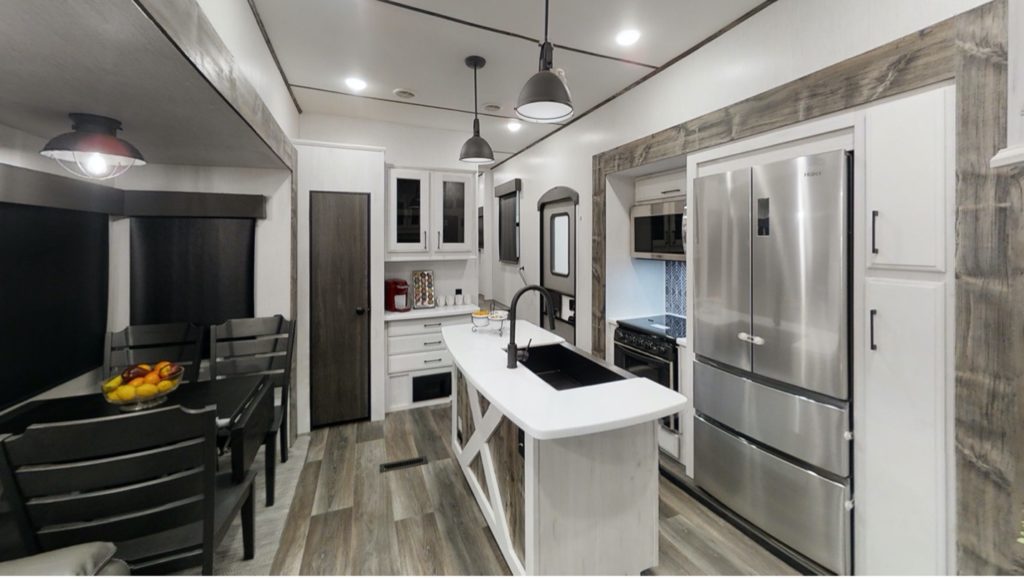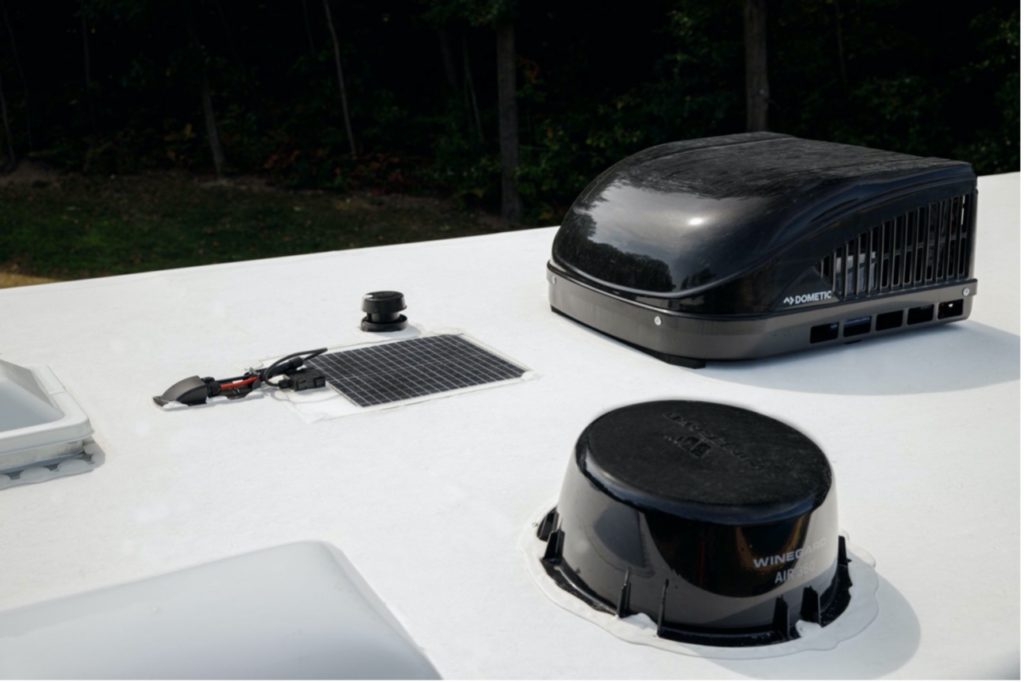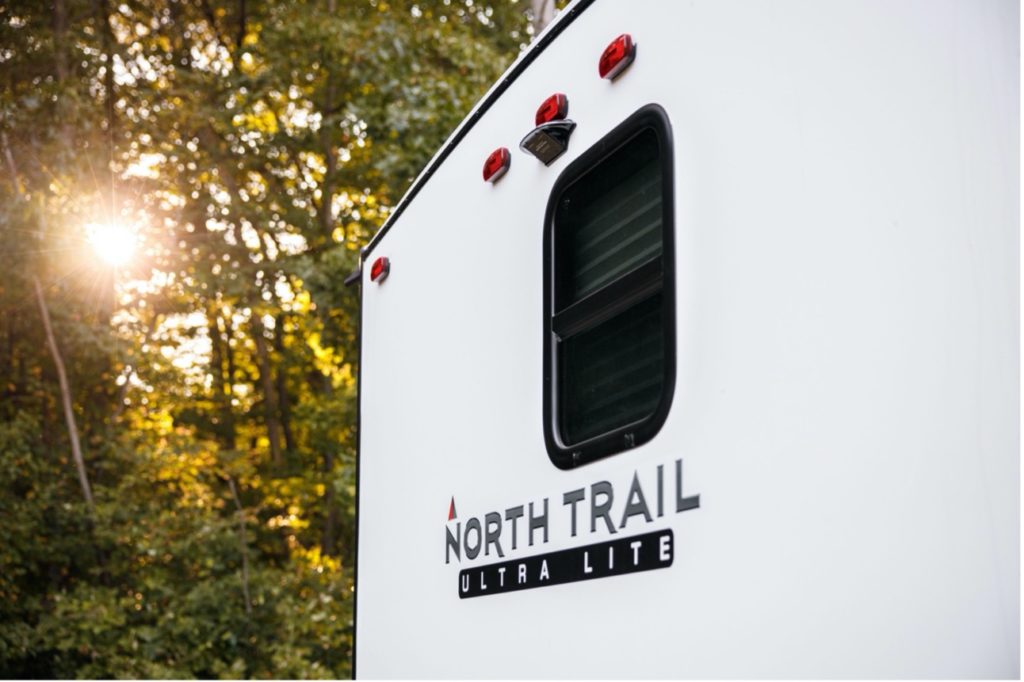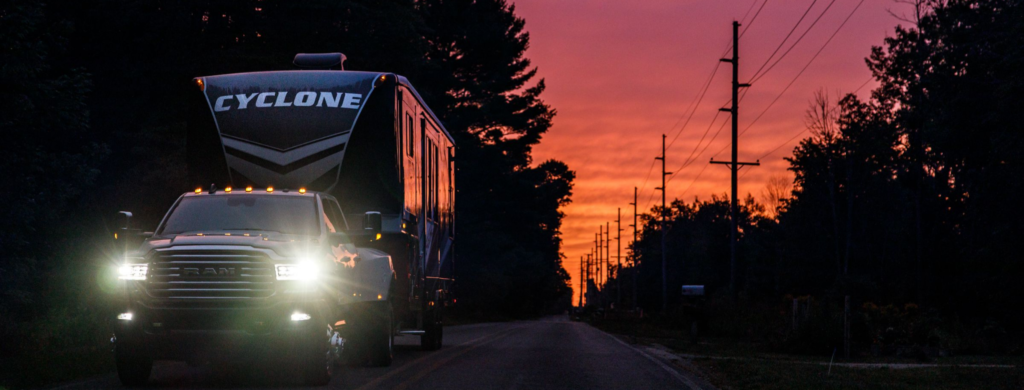GETTING YOUR RV READY FOR THE RV CAMPING SEASON
Another winter has come and gone, and if you’re like us, you’re anxiously waiting for the RV camping season to begin. You likely have your list of destinations, routes mapped out and campsite reservations booked. But what can you do to prepare for RV camping? Before you pack up and head off on your next journey, it’s important to properly de-winterize your RV and we’re here to tell you how to prepare for camping.
De-Winterization of Plumbing System
Depending on your RV brand and model, you’ll need the following tools before you begin:
- Screw gun with square bit
- 1-1/16 socket
- ¾ socket

Units with Anderson Valve and Single Lever By-Pass Valve
- Locate the Anderson valve. Attach city water supply to city water connection and set valve to city. Make sure all fixtures are in the off position. Turn your city water supply on.
- Go through unit and open each fixture one at a time until you have a solid clear flow of water from both hot and cold. Repeat this process for all fixtures including toilets, sinks, outside showers, and spray away systems.
- Locate anode rod or water heater plug depending on the model you have. Inspect anode rod or plug for damage or wear and replace if needed. Install anode rod using tread tape. Thread sealant isn’t needed with plastic plug.
- Locate water heater by-pass and turn to normal, once you have installed your water heater anode rod or plug.
You can watch a YouTube video of this process here: https://youtu.be/WUqX6y3BSDs
Units without Anderson valve and single lever by-pass valve
- Locate your city water supply connection, attach city water supply. Make sure all fixtures are in the off position. Turn your city water supply on.
- Go through unit and open each fixture one at a time until you have a solid clear flow of water from both hot and cold. Repeat this process for all fixtures including toilets, sinks, outside showers and spray away systems.
- Locate anode rod or water heater plug depending on the model you have. Inspect anode rod or plug for damage or wear and replace if needed. Install anode rod using tread tape. Thread sealant isn’t needed with plastic plug.
- Locate your water heater bypass valves on the back of your water heater, you’ll find three shut off valves, one on the hot supply line, one on the cold supply line and one on a cross over between the hot and cold supply lines. Turn both valves going to the water heater to the on positions. Turn the valve on the crossover to the off position. This should only be done once you have installed your water heater anode rod or plug.
Watch a YouTube video of this here: https://youtu.be/pt-dVRQEa1E
Checking your Plumbing System for Leaks
- Once you have de-winterized your unit. Pressurize your water system with city water, leave the water on during this entire process.
- Open each cabinet or access that has plumbing behind them including pass-thru storage areas.
- Using a paper towel or similar wipe each connection and check paper towel for wet areas. If paper towel becomes wet give the fitting a slight twist and re-check. Repeat this process for all fixtures including the water pump and water heater.

Checking your Wastewater System for Leaks
- With all your access panels removed and cabinet doors open, fill your sinks about half full of water. Fill your bathtub about a quarter full or shower base just below the perimeter rails.
- Let water stand for about 10 to 15 minutes. Check around the bottom of your drain connection with a paper towel or similar. If paper towel becomes wet give the fitting a twist and re-check. If just tightening doesn’t solve the issue contact your dealer or mobile tech service.
- Now that we have completed the fixture test, we want to flood the lines.
- Pull the fixture drain plug and visually check for leaks. Now that you have visually inspected, use a paper towel or like wipe around each fitting. Check paper towel for wet areas. If paper becomes wet, give the fittings a twist. If just tightening the fitting doesn’t resolve the issue contact your dealer or mobile tech.
- Repeat this process for each fixture.

Disinfecting and Sanitizing your Water System and Fresh Water Holding Tank
- Prepare a chlorine solution using 1 gallon of water and 1/4 cup of household bleach (Sodium hypochlorite solution). With tank empty, pour chlorine solution into the tank. Use 1 gallon solution for each 15 gallons of tank capacity. This procedure will result in a residual chlorine concentration of 50 ppm in the water system. If a 100 ppm concentration is required as discussed in item 3, use 1/2 cup of household bleach with 1 gallon of water to prepare the chlorine solution. One gallon of solution is used for each 15 gallons of tank capacity.
- Complete filling of tank with potable water. Open each faucet and run the water until a distinct odor of chlorine can be detected in the water discharged. Do not forget the hot water taps.
- Allow the system to stand for at least 4 hours when disinfecting with 50 ppm residual chlorine. If a shorter time is desired, then 100 ppm chlorine concentration needs to be permitted to stand for at least 1 hour.
- Drain and flush with potable water.
Check Batteries for Proper Voltage and Amperage
- Using a multi meter to check for proper voltage 12.6 to 12.8 volts with unit unplugged (Not charging)
- Check that battery is charging properly. Plug unit in and test battery with multi meter. Charging voltage should be between 13.6 and 14.4 depending on how much of a charge the battery already had.
- Have battery load tested. This can be done at most local auto parts stores. This will ensure that the battery has the amps needed to run slides and hydraulic leveling systems.
Check Tires
- Check tires for dry rot and cracking. Replace if dry rot and cracking is found.
- Check tire tread area for abnormal or uneven wear. If uneven wear is found, have suspension inspected for worn or damaged parts before replacing tires.
- Check for proper air pressure. You will find the proper inflation printed on the side of the tire.

Check Brakes and Wheel Bearings
- Brakes and wheel bearings should be inspected and serviced by a professional service provider.
- This service should be completed every 12 months or 30,000 miles whichever comes first.
Check Appliances for Proper Operation
- Turn on LP (liquid propane). Walk in and around unit looking for the odor of LP. If the odor of LP is not detected proceed to #2. If LP odor is detected check that LP bottle for tight connections, check to make sure all other LP appliances are turned off. If odor is still detected after you have followed the above steps, contact your dealer or mobile service provider.
- Light each stove burner and oven burner, flames should be blue, if yellow you will need to have it serviced by your dealer or mobile service provider. It may take a few tries to light after sitting over the winter.
- Open water heater door inspect burner and burner chamber for debris, rodent nest or damage. Clean out if needed and proceed with lighting instructions. Inspect for blue flame, if yellow contact your dealer or mobile service provider.
- Remove outer furnace cover and inspect for debris and rodent nest, clean out if necessary. Replace cover and follow operation instructions. If furnace fails to operate, contact your dealer or mobile service provider.

Check and Lube Slide Out Mechanisms
- Inspect for chipped or missing gear rack teeth.
- Inspect for worn or damaged parts.
- Run slide out and listen for squeaks and squeals.
- Lube using a dry spray lubricant product like CRC with PTFE.

Check Slide Operation and Seals
- Slides should run even and smooth.
- Check slide seal with slide in the closed position, bulb seal should have a minimum of 20% compression.
- Check wipe seals for contact on the slide end walls. Wipe seals should make full contact and be slightly cupped.
- Check seals for wear, tear, cracks, or other damages.
- If seals are sticky, use talcum powder or baby powder on the seals to help lube and keep from sticking to slide moldings and walls.
- If slides are out of adjustment or need seal replacement, contact your dealer or mobile service provider.
Check and Lube Stabilizer Jacks

Check Safety Equipment and Ladders, if equipped
- If equipped with a ladder. Make sure ladder is secure to wall and roof, ladder rungs are tight and there are no cracks or damage. Replace if cracked or damaged.
- Check that the fire extinguisher is secured in place and in working order.
- If fire extinguisher more than 10 years old, replace.
- Make sure all emergency escapes are in working order and accessible.
- Make sure breakaway has lanyard attached and is I working order. To check breakaway, with unit attached to tow vehicle and without bargeman cord attached, pull lanyard, with lanyard pulled try pulling unit forward. If the breakaway in functioning properly the unit will be hard to move. Replace lanyard back to its original position. If this test fails, contact your dealer or mobile service provider.
Clean and Inspect Roof

- Using a mild mix of soap and water and a medium bristle brush and scrub roof and components, rinse as you go. Make sure to pay extra attention to your component sealant, looking for voids, cracking and peeling. This should be done up to 4 times a year.
- If mildew is present, use bleach or Tilex and follow the instructions #1.
- If you find voids, cracks or peeling sealant, clean up all loose or peeling sealant.
- Wet a cloth with isopropanol alcohol and wipe down sealant. This will give the new seal a clean area to stick to. Sealant can be purchased from your local deal, online or through Heartland RV.
For more information on cleaning and care you may visit Dicor’s website at https://dicorproducts.com/product/dicor-epdm-rubber-roofing-3/.
Wash and Wax
- Wash and wax the exterior of your unit to protect the finish. This should be done at least 2 times a year.
- While washing your unit, this is a great time to inspect for cracked, peeling and or chipping sealants.
Resealing Your Unit

- Once you have washed your unit and identified cracked, peeling and or chipping sealant.
- Use a plastic glazing stick to clean out the bad areas of sealant and reseal with the proper sealant. Follow the link below for an instructional video on how to reseal and where you can purchase the proper tools for the job.
Learn how to reseal your unit here: https://youtu.be/CYAaFNm139A





